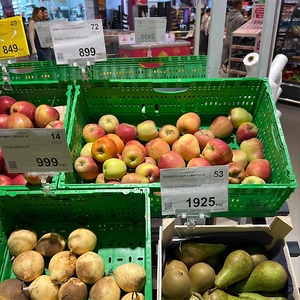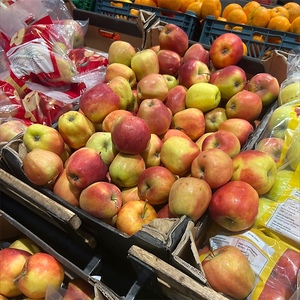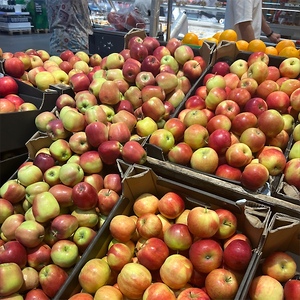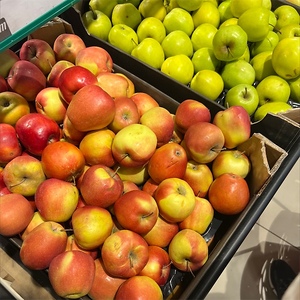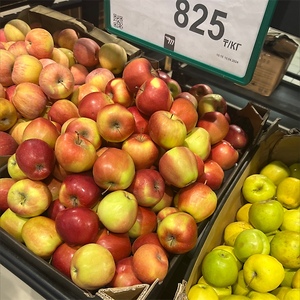


Gloster Apples
Estimated Inventory, 1 Lb : 0
Description/Taste
Gloster apples are a medium to large varietal, averaging 7 to 8 centimeters in diameter, and have a round, conical, to bell-like shape. The apples typically range from 160 to 200 grams in weight and showcase five distinct points at the base of the fruit. Gloster apples are lightly ribbed and have a yellow-green coloring, covered in large patches of muted, dark red to brick red blush. These blush patches can envelop the entire surface or be found in more minor spots, depending on cultivation and sun exposure. The fruit’s skin is smooth, tough, waxy, and semi-thick with a faint sheen, and prominent lenticels are scattered across the surface. Underneath the skin, the white-to-ivory flesh is tinged with green around the stalk and core and has a fine-grained, aqueous, firm, and crisp consistency. The flesh also encases a small central core filled with black-brown seeds. Gloster apples are aromatic and are edible raw when ripe. The variety has a mild, balanced, and refreshing taste with sweet, subtly sour, and fruity nuances.
Seasons/Availability
Gloster apples are harvested in the late fall through early winter and can be professionally stored through mid-spring.
Current Facts
Gloster apples, botanically classified as Malus domestica, are a German variety belonging to the Rosaceae family. The late-season fruits were developed through an apple breeding program in Northwestern Germany in the late 20th century and were released as a dual-purpose commercial variety. Gloster apples grow on deciduous trees reaching 4 to 8 meters in height and are valued by growers for their ability to hang well on the tree, survive cold temperatures, and produce consistently high yields. The variety also has tougher skin and extended storage properties, allowing it to be sold domestically and transported long distances. Since their release, Gloster apples peaked in cultivation in the 1990s and slowly faded from commercial popularity as newer apple cultivars have been introduced to retail markets. Despite their decline, Gloster apples have remained prevalent in local markets throughout some regions of Europe and are favored by consumers for fresh eating, baking, and juicing.
Nutritional Value
Gloster apples have not been extensively studied for their nutritional properties. Like other bi-colored commercial apples, the variety provides some potassium to balance fluid levels within the body, calcium to build bones and teeth, vitamin E to protect the cells against free radical damage, and vitamin C to strengthen the immune system. Apples also contain some vitamin A to maintain healthy organ functioning, phosphorus to repair cell tissues, iron to develop the protein hemoglobin for oxygen transport through the bloodstream, fiber to regulate the digestive tract, and other nutrients, including zinc, magnesium, manganese, vitamin K, and copper. The apple's pigmented skin contains anthocyanins, natural compounds with antioxidant-like properties to help reduce inflammation.
Applications
Gloster apples have a balanced, sweet, and sour flavor suited for fresh and cooked preparations. The variety is typically consumed out of hand, and the skin can be eaten or peeled, depending on preference. Gloster apples can also be sliced and served on cheese boards, layered into parfaits, or used as an edible topping over oatmeal, overnight oats, and pancakes. Try incorporating thin apple slices into burgers and sandwiches for added crunch or stuffing into fresh spring rolls. Gloster apples can be cut and used as a vessel for herb-based dips or a sweet snack dunked in caramel or chocolate sauce. The apples can also be tossed into salads or shredded into slaws. In Germany, Gloster apples are a popular variety for baking as their sweet and sour taste creates a choice flavor profile. The apples are baked into crisps, crumbles, cakes, muffins, and scones or added to pies, turnovers, dumplings, and fritters. They can also be simmered into jams, jellies, chutney, and compotes or cooked into sauces to serve with roasted meats. Beyond culinary dishes, Gloster apples are often pressed into juice for beverages or used in cider blends for enhanced flavoring. Gloster apples pair well with herbs such as mint, cilantro, and parsley, cheeses including cheddar, gouda, brie, and goat, nuts such as pecans, almonds, walnuts, and meats including poultry, turkey, and pork. Whole, unwashed Gloster apples will keep for several weeks to months when stored in a cool, dry, and dark place, such as a cellar or the refrigerator’s crisper drawer. In professional cold storage, the variety will last up to three months but will become softer over time.
Ethnic/Cultural Info
Gloster apples are also known as Gloster 69 apples in some European markets. The variety was commercially released in 1969, revealing the reason the apple was given the number 69 in its moniker. The name Gloster was said to have been created from the beginning portion of one of the apple’s parent varieties, Glockenapfel. “Glo” was taken from Glockenapfel, also known as the Bell apple, to create Gloster. In Germany, Gloster apples are a popular variety chosen for organic home gardens and specialty orchards. It is said the cultivar is stable in organic cultivation methods and offers some disease resistance.
Geography/History
Gloster apples are native to Germany and were bred in 1951 in the Lower Saxony region of Northwestern Germany. The variety was developed at Obstbauversuchsanstalt Jork, also known as the Jork Fruit Growing Experimental Station, and was created from a cross between Glockenapel and Richared Delicious apples. Dr. Loewel, the former director of the research station, helped to breed Gloster apples, and the variety was evaluated and tested for eighteen years before it was commercially released. Gloster apples were introduced in 1969 and quickly became a popular cultivar in Central Europe. The variety remained prevalent in commercial markets up until the 1990s, eventually being overshadowed by other modern apple introductions. Today, Gloster apples are still widely planted throughout Northern and Central Europe as a small-scale commercial cultivar and home garden tree. The variety is also grown in Western and Southern Europe, mainly the United Kingdom, France, and Italy, and is also cultivated in Central Asia.



